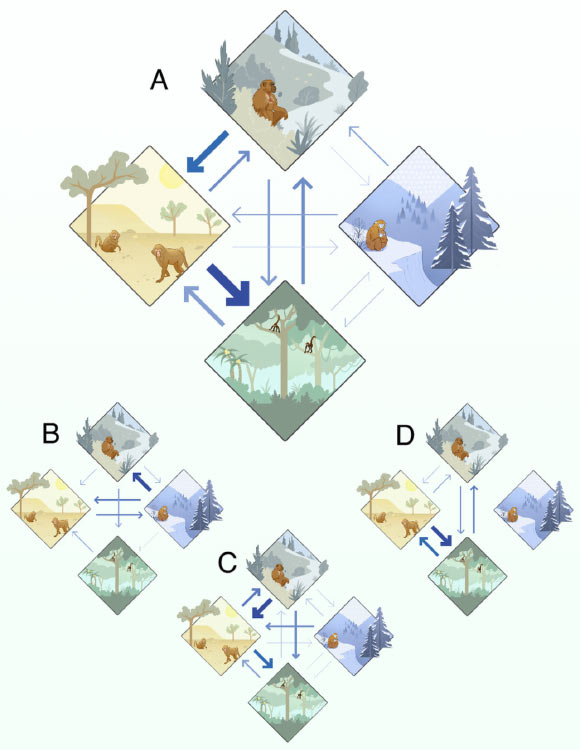Textbooks often portray primates as originating, evolving, and dispersing exclusively within warm tropical forests. This tends to come from fossil evidence distributed across tropical latitudes. However, new research led by University of Reading suggests first primates most likely lived in North America in a cold climate with hot summers and freezing winters.
Primates historically transitioned across diverse climates: (A) transition between the temperate (top), arid (left), tropical (bottom), and cold (right), main climates, for all primates; arrow size represents the proportion of phylogenetic branches with the respective transitions; (B) climatic transitions for early primates, who were living between 65 and 47.8 million years ago; (C) climatic transitions for species that were living between 47.8 and 23.03 million years ago; (D) climatic transitions for species that were living from 23.03 million years ago to the present. Image credit: Avaria-Llautureo et al., doi: 10.1073/pnas.2423833122.
In the study, University of Reading researcher Jorge Avaria-Llautureo and his colleagues used statistical modeling and fossil data to reconstruct ancient environments and trace where the common ancestors of all modern primates lived.
“For decades, the idea that primates evolved in warm, tropical forests has gone unquestioned,” Dr. Avaria-Llautureo said.
“Our findings flip that narrative entirely. It turns out primates didn’t emerge from lush jungles — they came from cold, seasonal environments in the northern hemisphere.”
“Understanding how ancient primates survived climate change helps us think about how living species might respond to modern climate change and environmental changes.”
Primates that could travel far when their local weather changed quickly were better at surviving and having babies that lived to become new species.
When primates moved to completely different, more stable climates, they traveled much further distances — about 561 km on average compared to just 137 km for those staying in similar, unstable climates.
Early primates may have survived freezing winters by hibernating like bears do today — slowing down their heart rate and sleeping through the coldest months to save energy.
Some small primates still do this — dwarf lemurs in Madagascar dig themselves underground and sleep for several months when it gets too cold, protecting themselves from freezing temperatures under layers of roots and leaves.
Primates didn’t reach tropical forests until millions of years later.
They started in cold places, then moved to mild climates, then to dry desert-like areas, and finally made it to the hot, wet jungles we see them in today.
When local temperatures or rainfall changed quickly in any direction, primates were forced to find new homes, which helped create new species.
“Our results suggest that nontropical, changeable environments exerted strong selective pressures on primates with higher dispersal ability — promoting the primate radiation and their subsequent colonization of tropical climates millions of years after their origin,” the authors said.
Their paper was published August 5 in the Proceedings of the National Academy of Sciences.
_____
Jorge Avaria-Llautureo et al. 2025. The radiation and geographic expansion of primates through diverse climates. PNAS 122 (32): e2423833122; doi: 10.1073/pnas.2423833122
